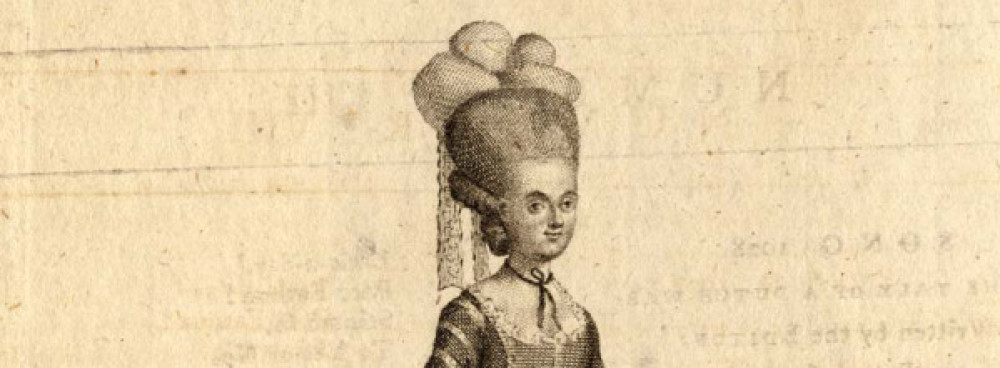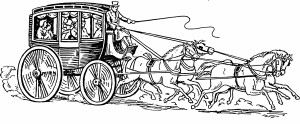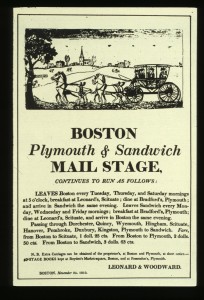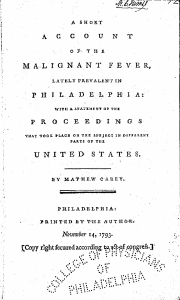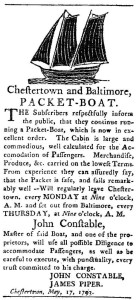In the last decade of the eighteenth century, actresses at theatrical centers in the United States often traveled to other cities, either as members of a theatrical troupe or as individuals seeking additional performance opportunities. Performers traveling between New York and Philadelphia went overland by stagecoach; however, those traveling from Philadelphia to Baltimore and Annapolis or to Charleston often traversed by ship, either packet or sloop.
As French dignitary St. Mery relates, in the summer, a stage could leave Philadelphia at one a.m. and arrive at New York on the same night.[1] In 1792, the “post” bound for the South left Philadelphia on Mondays, Wednesdays, and Fridays at nine o’clock in the morning and reached Baltimore at three p.m. on the subsequent day and Alexandria on the day after that.” [2] Actresses had to travel to other cities to further their careers. The Philadelphia company usually spent a few weeks in Baltimore every season and occasionally performed in Annapolis. For one season, the New York troupe performed in Philadelphia when the Philadelphia troupe performed in Baltimore. In addition, theatrical companies often removed to other theatrical centers when their home theatre was closed; for example, in 1797 when Philadelphia was in the midst of a yellow fever epidemic, the theatre troupe performed in New York. [3] In his journal, William Warren, new manager of the Chestnut Street Theatre, wrote, “Sunday, August 13, 1797 @ 9 – must go to New York as the Yellow Fever has made its appearance in the City and the people beginning to fly.[4]Warren records more details of the journey to New York:
Thursday, July 17
We leave Philadelphia. The stage was chartered by Anderson to convey the party—consisting of Mr. and Mrs. Merry, Mr. and Mr. Gillingham, Mr. Reinagle, Mr. Anderson, myself and wife—we sleep at Prince town [sic] that night.
Friday, July 18
Arrive at NY at 2 p.m. Put up at tavern at bottom of Courtland Street.
Sat. July 19
We take lodging at Mrs. Shacktens (or Shackless) in Pearl St. at $3 per week intending to board ourselves for the sake of cheapness and privacy.[5]
Actresses also traveled to other cities as individuals, without the rest of the troupe. Mary Ann Wrighten Pownall and Dorothea Broadhurst sang in concerts in Boston during some summer months. In addition, most of the actresses left their home theatres and joined other troupes at points in the careers; for example, Mary Ann Wrighten Pownall, Dorothea Broadhurst, and Charlotte Melmoth were engaged by the Charleston theatre company.
Travel by stagecoach was tedious. Before roads were improved in the 1800s, stagecoach travel was jarring and uncomfortable; passengers sat on backless benched with their belongings stashed beneath their seats.[6] Passengers also feared the competence of the drivers; St. Mery complained that the drivers were “always slightly drunk” and drove too fast.[7] Mrs. Melmoth, in fact, was the victim of a stagecoach accident that caused false reports of her death to appear in newspapers throughout the United States:
Travel by ship also proved difficult; performers would depart and arrive at inopportune hours. William Warren recordedAt New Brunswick, N.J. in consequence of the injury she received by the overturning of the stage, Mrs. Melmoth, a celebrated actress, formerly of the New York Theatre.[8]
“At 9 a.m. go on board Captain Barbers packet—all day—all night on the water. Arrive at daybreak.”
In some cases, the company had to wait six hours for the tide.
Occasionally, theatrical personnel had to walk to other cities, as notated in Warren’s journal:
June 30, 1798
Walk to Annapolis; the day is hot– we could not reach it until next morning—hired a lodging and board ourselves.[9]
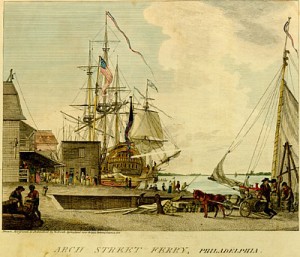
By Engraving by William Birch, from The City of Philadelphia, 1800, Independence National Historical Park (A Short History of Yellow Fever in the US) [Public domain], via Wikimedia Commons
November 27, 1799 –
Leave for Philadelphia in packet; arrive at F Town [sic] at 8 p.m.—poor accommodations. The ladies only could obtain beds the men do without.
To keep theatre companies solvent, performers had to travel to other cities to tap new audiences, and travel in the Early Republic was challenging.
NOTES
[1] Moreau de St. Mery, Moreau de St. Mery’d American Journey 1793-1798. Translators and editors Kenneth Roberts and Anna M. Roberts (Garden City, NY: Doubleday & Company, Inc., 1947) 96-97.
[2] Stephen Decatur, Private Affairs of George Washington from the Records and Accounts of Tobias Lear, Esquire, his Secretary (Boston: Houghton Mifflin Co., 1933) 269-270.
[3] William Warren, William Warren’s Journal, Vol. I, Channing Pollock Theatre Collection, Howard University, Washington D.C.
[4] Ibid.
[5] Ibid,
[6] Frederic Wood, The Turnpikes of New England and Evolution of the Same Through New England, Virginia, and Maryland (Boston: Marshall Jones Co., 1919) 47.
[7] St. Mery, 96-97.
[8] Boston Gazette, 28 May 1812.
[9] Warren, 30 October, 1799.
